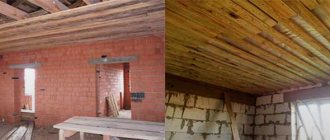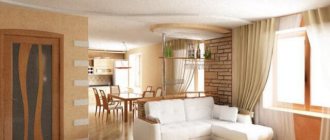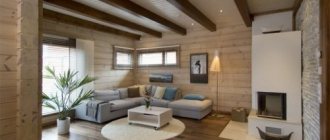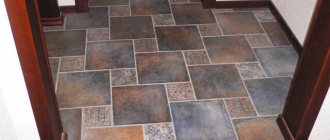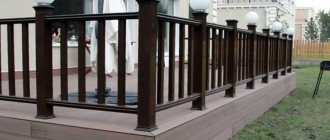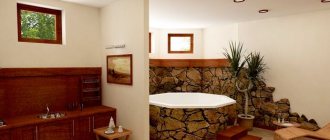An important part of comfort, coziness, and psychological sensations is the height of the ceilings in a private house. There are standards and rules that declare the specified parameter in relation to the purpose of the room. The height of the ceilings is of particular importance when it comes to designing a private house. For apartments, this parameter is strictly regulated - this range is from 2.5 to 2.7 meters.
Ceiling height in the living room
Correct planning further eliminates the issue of installing decorative elements inside the room. When solving a problem, as a rule, they prefer the standard option. The layout of the space in the boiler room requires special attention. It is possible to determine whether the choice was made correctly only after check-in. However, you can pay attention to important details and estimate the positive and negative aspects during design.
Pros and cons of different ceilings
The optimal ceiling height in a private house is an average value. If the task is to build comfortable housing without much sophistication at minimal expense, the most correct solution is to follow standard dimensions. At the same time, the standard dimensions of 2.6 meters easily avoid many disadvantages and make life in the house pleasant for its inhabitants.
A private house
High ceilings
They have their disadvantages:
- Costs during the construction phase of the building will be higher. This also entails increased costs for interior decoration.
- Complex organization of the heating system, the operation of which will require significant funds.
- Increased complexity of repair work. Repairers will be forced to use special structures. This entails an increase in the cost and time of repair work.
- Difficulties that occur in everyday life. A special approach is required when servicing and cleaning the premises. Even replacing a light bulb can cause difficulties.
Pros:
- They contribute to the formation of a specific atmosphere and a feeling of spaciousness.
- Lots of room for imagination when decorating. Such ceilings contribute to the creation of an individual floor design; it is possible to use several levels using various decorative solutions from plasterboard. They are perfect for the Baroque style, which involves the presence of a variety of stucco moldings, as well as for the classics.
Standard project
Experts recommend decorating a space with high ceilings following the “rule of three” - the walls are divided into three sections. The lower level is intended for auxiliary decoration, the middle level is occupied by shelves and paintings.
It is not recommended to place paintings below eye level, otherwise there will be a feeling of emptiness. The last section of the wall, the top, is left empty. This breakdown allows you to visually raise the ceiling level even more. For lighting it is recommended to use large chandeliers. Thanks to them, the room will become elegant and chic.
Low ceilings
Pros:
- They create a feeling of pressing overlap, which causes discomfort from staying in the room.
- It is impossible to use large chandeliers, especially in relation to a ceiling 2 meters high - a large chandelier will create an unfavorable environment.
- Restriction on decorative design - a multi-level ceiling will be irrational. Its creation is accompanied by difficulties, and its implementation in practice is only possible when turning to highly qualified specialists.
Ceiling height in a private building
The advantages of low ceilings lie in the disadvantages of high ones; it makes no sense to dwell on them in detail. When designing a room with low ceilings, experts recommend abandoning the following elements:
- lampshades, massive floor lamps;
- stucco on the ceiling, the use of volumetric decorative elements;
- large wardrobes, high tables and bulky sofas;
- Painted curtains fixed directly to the wall are suitable for ordinary ones - plastic ones fixed to the ceiling.
Designers believe that it is better to focus on the texture and color of the room. A good solution would be to use white as much as possible. This color helps to visually increase the space.
Hallway
The walls and ceiling can be decorated using shades of white. When decorating the interior of a room, it is preferable to use mirrored, glossy materials. Reflective surfaces also help to visually increase the cubic capacity of the room. The best solution is a glossy stretch ceiling.
Geometric parameters of the room
Experts are unanimous in their opinion that ceiling dimensions range from 2.6 to 3 meters. In order to determine a more specific value, it is necessary to understand the layout of the building and indicate its purpose. Cyclic or seasonal operation of the building is possible.
Diagram of a two-story house with high ceilings
When it comes to a summer country house consisting of small rooms, you can stop at a ceiling height of 2.6 meters. Such buildings do not imply the presence of large living rooms and wide halls; high ceilings do not make sense.
However, when we are talking about a house as a permanent home, large bedrooms and spacious living rooms are well suited. This requires high ceilings, especially if you plan to place bunk beds.
Construction from timber
How to calculate the optimal ceiling height for design and renovation
As can be seen from the descriptions of different housing, the standard ceiling height may vary, it can be clarified and compared in the table below.
Table 1. Standard shelf height in different types of houses.
In addition to the standard one, there is such a thing as optimal ceiling height. It takes into account not only the SNiP requirements for microclimate and safety, but also the ergonomics of the premises and the combination of dimensions in all three dimensions. It should be noted that the optimal ceiling height should not be lower than the regulated one.
Table 2. Selection of optimal ceiling heights in various rooms.
| Terms, illustrations | Short description |
| Condition 1. Microclimate and air exchange | For living rooms and kitchens, the optimal ceiling height in the final finish should be no less than the height of the tallest family member plus 1 meter. This is due to the fact that the upper meter layer of air in the room contains a maximum of dust, bacteria and harmful gases formed during breathing and operation of heating devices. To ensure good health, you need to avoid inhaling air from this layer of air. With an average height of 170 cm, the finished ceilings are 2.7 meters high. |
| Condition 2. Heating and costs for it | You should not excessively increase the ceiling height - this will significantly increase the cost of heating. Thus, for a house with an area of 100 m2, an increase in the distance from floor to ceiling by 30 cm threatens to increase the cubic capacity of the building by 30 m3, which will require the installation of more powerful heating equipment and increase heating costs. |
| Condition 3. Number of storeys and layout | For a two- and three-story house, too high ceilings are also undesirable, and not only because of increased construction costs. The staircase to the upper floors with an increased ceiling height will take up a large area or will have a too steep slope, which is inconvenient and sometimes unsafe. If you want a spacious living room or hall in a two-story house, use a layout with a second light, as shown in the picture. In such a house, the ceiling height in the living room or hall occupies both floors. |
| Condition 4. Purpose of the premises | It makes no sense to make high ceilings in rooms with temporary occupancy: in a pantry, garage, small corridor. A height of 2.2-2.5 meters is quite sufficient for them. Also, you should not make high ceilings in the bathhouse and sauna - this will make it more difficult to heat it to the desired temperature. They have enough 2.2-2.3 m. |
| Condition 5. Room area | The basic rule: the more spacious the room, the more appropriate high ceilings are. So, for a living room or dining room with an area of 20 m2 or more, a ceiling height of 3.0-3.5 meters is suitable; for the kitchen, bedroom and nursery, 2.7-3.2 meters is enough; for a bathroom – 2.7-3.0 meters. You can achieve different heights in different rooms through suspended or tensioned structures and ceiling decoration. In addition, communications and ventilation systems can be hidden under them. |
Although the standard ceiling height is regulated by code, its value can vary greatly. When purchasing a new or secondary home, this parameter must be clarified in the technical passport for the apartment or house, or measured independently. When building a private property, it is better to be guided by personal needs and preferences, because the correctly chosen height of the premises will not only create the desired style and interior in the house, but also provide a comfortable environment there.
Optimal value
Applied calculations for selecting foundation parameters are based on the bearing capacity of the soil and the total pressure of the structure on the site. To ensure optimal conditions for the durability of the structure, engineers select the required width and depth of the tape.
From the type of construction
Materials that are suitable for load-bearing walls in a house differ in their structure and are differently susceptible to moisture. Therefore, the distance from the zero mark to the floor level will reasonably depend on the main building material from which the structure will be erected.
The relationship between design parameters is shown in the table:
| Type of structure | Recommended plinth height, m |
| Brick and monolithic houses | 0,3–0,4 |
| Buildings made of foam blocks and large-sized ceramic materials | 0,4–0,5 |
| Frame, wooden structures | More than 0.5 |
Wood is most susceptible to rotting under the influence of high humidity, so for this type of construction it is prudent to choose the maximum possible height of the base. The costs of constructing such a foundation are compensated by the absence of the need to carry out major repairs of the structure due to rotting and destruction of the house.
Depending on the number of floors and the total load of the structure
To determine the dimensions of the foundation, engineers need to analyze the type of soil, groundwater levels and the load of the structure.
For example, when designing a garage, bathhouse or frame house, you need to lay a foundation 0.6–0.8 m high. Of this, 0.4–0.5 m of tape will go deep, and the rest will protrude above the ground, acting as a base.
According to English technology, the height of the tape should be less than or equal to its depth. But in practice, this can lead to unnecessary overexpenditure of resources. To achieve this, in Russia builders adhere to the rule that the height of the base should be no more than four times the width of the base.
For a shallow foundation, the following tape widths are accepted:
- lightweight outbuildings - from 0.25 to 0.4 m;
- one-story houses - from 0.3 to 0.65 m;
- two-story buildings - from 0.65 to 0.9 m.
The value of the parameter is from 0.2 to 0.9 meters - the permissible dimensions of the basement for houses for which it is not planned to build a basement. If a structure with a ground floor or basement is being built, then the part of the foundation protruding above the ground can reach 2 m.
Standards and Practices
Despite the fact that the standard ceiling height of 2.5 meters is practically never found in new houses, this does not mean that after purchasing an apartment in a new building, a happy new resident will not receive rooms with low, oppressive ceilings. If the quality of construction leaves much to be desired, the ceiling surface will inevitably require additional leveling, which can significantly reduce the space. Therefore, the standard and practical conditions in a number of new buildings are different concepts.
Norms
Not a single regulatory document or standard establishes the only correct parameter. SNiP specifies only the minimum ceiling height. Below this parameter, construction is unacceptable. SNiP makes the following recommendations:
- In living rooms and kitchens, the lower figure is 2.5 m. For climatic regions 1A, 1B, 1G, 1D and 4A - 2.7 m.
- In corridors and halls, the ceiling height must be at least 2.1 m, which is determined by the safety requirements for the movement of people.
- Attics and rooms with inclined enclosing structures are allowed to be built with a height less than the standard one. The standard in this case determines the percentage of room space with low and standard ceilings. Ceilings with a lower height should occupy no more than half of the room.
- The height of the lowest part of the attic ceiling cannot be less than 1.3 meters if the slope is 30°. When the slope increases to 45°, the distance from floor to ceiling is not standardized by SNiP.
- For public buildings, SNiP sets a standard of 3 m.
- Residential premises located in public buildings are equipped in accordance with the recommendations developed for apartments.
Ergonomics issues
If the minimum distance from floor to ceiling is determined by SNiP, then ergonomics is involved in developing optimal parameters. The tasks of this science include calculating the room parameters that will allow a person to feel as comfortable as possible. It's no secret that a room with a low ceiling can feel pressured. A tall room with a small area will also be uncomfortable. Here a person feels as if in a well.
A comfortable room must meet the following ergonomic requirements:
- Sufficient amount of natural light.
- Sufficient amount of fresh air.
- Optimal humidity conditions.
Compliance with these requirements largely depends on the size of the room and the height of its ceilings. The optimal ceiling height was first substantiated by Dürer. Further research was carried out by the German architect Ernst Neufert, who developed modules with ideal parameters. These and other studies were subsequently taken as the basis for SNiP standards.
A little about the history of the issue
The design of houses of various heights is dictated by the need to save space, which arises in conditions of total urbanization.
Sample plan for a 9-story building
The expansion of large cities and megalopolises in width leads to the seizure of areas that could serve as agricultural land. Therefore, there was an urgent need for the design and construction of multi-storey buildings. Here are some examples:
- the first 4-story frame-panel house in the Soviet state was built in Moscow in the post-war period (1948);
- at the same time and a little later in Moscow, a residential area was built up with houses of 10 floors;
- the first frameless panel house, 7 floors high, was built in 1954, also in the capital;
- the construction of 5-story buildings was chosen for reasons of economy - this is the maximum number of storeys that allows construction without an elevator;
- For the first time, the construction of a 9-story panel house began in 1960.
Without an agreed project with all parameters, it is impossible to start construction
You can determine with accuracy how tall a 9-story building is using a standard code that was used to designate standard projects in the USSR. The index indicated the type of building and wall material (panels, load-bearing frame, blocks, bricks, etc.), series number and serial number of the project. Sometimes there are two more numbers, 1 or 2, indicating the period when it was adjusted.
By looking up the documents for the series, you can accurately calculate the height of a 9-story building in meters in a particular design of a typical type of building. The designation also included data on the expected climatic conditions (seismic, permafrost, subsidence, etc.), as well as the degree of durability of the 9-story building, which the creators of the project expected (the number 1 meant up to one hundred).
Viewing the plan requires knowledge of numerical and letter designations according to GOST
In different types of houses
In apartments, the ceiling height can be different, as it depends on the building construction project. Today on the housing market you can find houses with both old and new layouts. For example, housing in “Stalinka” is characterized by a large area, the rooms are often decorated with beautiful platbands and stucco molding, and the height of the walls in them reaches from 3.2 to 3.5 m.
No less popular are the “Khrushchev” apartments, which are characterized by a small living area, good sound insulation and high-quality ceilings with a height of 2.5 to 3.2 m. With the change of era, they were replaced by apartments of a new type - “Brezhnevka”, their premises became more spacious, and the project even included the addition of hallways.
The majority of the housing stock consists of panel houses. The first buildings were built on 5 floors, the ceiling height did not exceed 2.5 meters.
Today you can buy an apartment not only in a five-story panel building, but also in nine-story buildings. It is difficult to renovate housing with such a layout, since you will have to not only visually raise the ceilings, but also dismantle the partitions.
As for the owners of apartments in new panel buildings, they are lucky, since the height of the ceilings of the rooms has become much larger - from 2.7 meters.
Houses of a new type deserve special attention; in their monolithic apartments, designers create a variety of types of layouts, thanks to which the housing becomes elite and meets all levels of comfortable living.
There are also economy-class apartments in new buildings, in contrast to the business class, which is characterized by a room height of 3 m; in them this figure is 2.7 m.
In an apartment building, some of the rooms may be located on the attic floor; as a rule, space is allocated there for bedrooms or kitchens. In order to organize the top floor as much as possible and make it residential, the height of the attic cannot be less than 2.1 m.
The best interior options for a three-room apartment in Brezhnevka
Having three rooms suggests the greatest flexibility to change. Variability allows you to turn many ideas into reality.
Any work on redevelopment and renovation of an apartment must be entrusted to professionals.
Frequent options and techniques used by interior designers:
Expanding the space of the bath and toilet by installing a corner bath instead of a full-size or shower. Another common solution here would be to remove the partition between the bathroom and the toilet, which will optimize the space and make it not only visually, but actually more. If there is one large room, then it is often zoned, creating additional space. The partition can be conventional or made of a specific material. If there are two small rooms and they are separated by a non-load-bearing wall, then they are often combined, freeing up additional space. Sometimes this is designed in the form of a large arch, in other cases the trace of the wall is completely removed. Using the built-in cabinet in the kitchen as “plus one meter”, because usually this room was quite small. If you demolish the wall between the balcony and the kitchen, the area will then increase by 1.5 times. And in such buildings, the layout usually assumes exactly this position of these premises
It will not be difficult for specialists to study the apartment plan, conduct a detailed analysis, select suitable repair options, and coordinate all redevelopment work with higher authorities.
Why is height so important?
The standard ceiling height in an apartment (h = 2.5...3.2 meters) often does not allow its owner to realize his interesting design ideas. Having high ceilings in a house is always an advantage, because in such houses there is more light and air, and there is no feeling of enclosed space.
The design project of a room with high ceilings (h=3.2...3.7 meters or more) allows you to embody bright ideas and the most daring decisions.
To avoid the feeling of emptiness, in apartments with high ceilings you can not only hang a multi-level crystal chandelier, but also create an additional attic floor - a recreation area, to which a small staircase leads, and at the top there is an additional sleeping area and a library.
Arrangement of space in residential premises with high ceilings has some features:
For the interior of large rooms with high ceilings, it is recommended to choose massive large furniture
At the same time, it is important not to visually overload the room, so as not to erase the feeling of light and space
It should be noted that the design of a living space with a high ceiling is often done in the loft style (a modern style that can be described by the motto: “fewer partitions, more fresh air”). This style emphasizes the advantages of the room and organizes hidden places for storing things, effectively organizing the surrounding space. But for some owners of living spaces with high ceilings, the Art Nouveau style is to their liking.
Regardless of adherence to style, there is a vast field for imagination. Shaped arches, decorative elements of varying complexity, tension or suspended multi-tiered ceiling structures will look very beautiful and relevant in such rooms. Another advantage of such a room is that there will be no need to set the ceiling level to a centimeter, since they are invisible in the general space.
Pros and cons of low ceilings
Low ceiling is a relative concept. For large rooms, a height of 2.8 may seem insufficient, and for a small bedroom, where a person spends time mainly lying down, a ceiling of 2.4 m will not look low. When choosing the height of ceilings in a country house, you need to focus on the size of the rooms so that their proportions are harmonious.
- cause a feeling of lack of freedom, pressure;
- limited in the choice of ceiling lamps;
- make design solutions such as tension or suspended structures impossible.
- give the interior an unpresentable look.
But they also have advantages, because by reducing the height of the walls in a private house, construction costs are saved and heating costs are reduced.
Taking into account all these pros and cons, the optimal ceiling height for each room in a private house is determined so that aesthetics and economics are in a reasonable balance.
Metal ceiling
Metal floor beams are made from low-alloy or carbon steel.
Metal beams are a more durable material than wooden beams and have a longer service life. Due to their strength, you can save space by reducing the thickness of the ceiling itself. It is worth noting that floors using metal beams are used extremely rarely; more often, builders opt for wooden floors.
The openings between the beams are filled with a mixture of lightweight concrete or wooden panels. The weight of one square meter of such flooring exceeds 400 kg.
Using metal beams with your own hands, you can cover large spans, from four meters or more. The metal floor is a non-flammable material and exhibits a high degree of resistance to various biological factors such as rot or termites.
The disadvantages of this overlap include the tendency to form corrosion in places with high levels of humidity. The ceiling made of such material has low sound and heat insulation properties. This situation can be corrected if the ends of the beams are wrapped with felt.
In most cases, a rolled profile is used as a load-bearing element: angles, I-beams, channels. During installation work, reinforced concrete slabs up to nine centimeters thick are laid between the beams. A layer of reinforced concrete screed and slag is applied on top.
For this type of flooring you will need the following materials:
- metal beams;
- prefabricated reinforced concrete slabs;
- plaster mesh;
- waterproofing materials;
- boardwalk.
In rare cases, reinforced concrete beams are used for flooring in a private house. Their disadvantage is that the work cannot be done with your own hands. The use of lifting equipment is mandatory.
Design solutions and ergonomics
From an ergonomic point of view, the parameters of the room should be such that a person feels comfortable in an apartment, gym, or cinema.
There are several basic postulates of room comfort:
- optimal microclimate (comfortable temperature and humidity);
- necessary supply of fresh air;
- sufficient natural or artificial lighting.
The standard ceiling height in an apartment will allow you to create almost any floor structure, with the exception, perhaps, of heavy multi-tiered hanging devices. When making such design solutions, the height from floor to ceiling should be maximum.
In other cases, you can use any materials:
- ceiling tiles;
- tensile structures;
- simple suspended ceilings.
Ceiling tiles are suitable for finishing rooms with any wall height. It practically does not hide or reduce spatial scales. Easy to install and maintain. During repairs, any home craftsman can handle gluing. The only drawback is that it will not be able to level the floor slabs; moreover, when glued to an uneven surface, it can come off and negate all the work in the future.
Tension fabrics are the most acceptable option for finishing ceilings. They do not require special surface preparation. The width of the profiles on which the canvas is attached is not too large. But it is worth noting that multi-level structures should not be used in rooms with low ceilings. In such rooms, a single-level glossy or matte canvas with spotlights would be optimal.
Tension fabrics with a 3D effect and original lighting are possible, which can be selected taking into account the fact that the ceiling will visually look higher.
Suspended ceilings can bring to life the most daring design solutions. The installation of structures is carried out without preparing the base, especially since it is possible to hide light fittings and other communications under such a ceiling.
With high ceiling heights, you can create a multi-level, stylish and elegant form. In a room with low ceilings, it is better to opt for a single-level option with original built-in lamps or a chandelier that allows you to illuminate the ceiling surface from below.
What should be a comfortable ceiling height and what is this value in practice?
Ceiling height is an important parameter, the value of which determines the level of comfort in the room and the possibility of implementing certain design ideas. Different types of premises have their own standards. Such values are indicated in regulatory documentation, and ergonomics also deals with these issues.
Ergonomics of residential premises
The science of ergonomics develops parameters for the optimal ceiling height at which a person would feel as comfortable as possible.
To create a comfortable atmosphere during construction, the following ergonomic conditions must be observed:
- plenty of natural light;
- sufficient oxygen;
- maintaining optimal humidity conditions.
These requirements will differ depending on the size of the room.
The first optimal values were calculated by Dürer and Ernst Neufert (about 2.7 m). They are the basis for calculating standard ceiling heights in SNiP - building codes and rules used during construction.
Norms
It is worth noting that regulatory documents do not establish the only correct value, but only indicate the minimum ceiling height for residential premises of various types. Construction below it is not permissible.
- Living quarters and kitchens – 2.5-2.7 m.
- Corridors and halls – 2.1 m.
- Boiler rooms – 2.2 m.
- Baths, steam rooms, saunas – 3.2 m.
- Dry cleaners and laundries – 3.6 m.
- Offices and other administrative facilities – 3 m.
On practice
The modern indicator of the distance from ceiling to floor depends on many factors. The main one is the standard of living of the owners of the premises. In apartment and private buildings, as well as cottages that are built for further sale, developers can take into account the wishes of customers. As they say, every whim is for your money. Typically, the height of ceilings in a panel house fluctuates between 2.5-3.2 m. It is believed that a value of 2.5 m is the lower threshold at which there is no feeling of discomfort and a “pressing” effect.
The height of Stalin's ceilings
The height of apartments in Stalinist buildings is 3-4 m. They were built back in the 30-50s of the twentieth century during the reign of Stalin. These apartments are large and bright, have wide corridors, voluminous door and window openings, spacious bathrooms, kitchens, and rooms. We can safely say that such premises fully comply with ergonomic requirements.
Ceiling heights in Brezhnevka
High-rise Brezhnev buildings (from 9 to 16 floors) appeared in the USSR in the 70s. At first, the premises in them were called apartments with an improved layout. If you compare them with the rooms in Khrushchev, then it really looked like the truth. The distance from the floor to the ceiling surface in Brezhnev's houses is 2.5–2.7 m. The total area of the apartment is 20-80 sq. m. m.
Ceilings in new buildings
Today, different standards are applied when building houses. Elite class apartments can have a height of 3 m or more. The cost per square meter of such housing is significantly higher than average. In budget options, they stop at a value of 2.7 m, which is considered optimal both from the financial side and from the point of view of comfort. The average height of rooms in a nine-story building is 2.6–2.8 m.
Stretch ceiling
Tensile structures are recommended to be installed in high rooms from 2.7 m, as they tend to hide space. How much the ceiling height will be reduced depends on the type of mounted lamps and utilities. Typically this value is about 10 cm. The minimum distance between the main and suspended ceiling covering should not be less than 3 cm.
Advice! In low rooms (less than 2.4 m), stretch ceilings should be used with caution. The best option in this case is simple single-level structures
If the room allows, then the space for design imagination is not limited, and it is quite possible to settle on three- or four-level structures with complex configurations.
How to visually increase the height of the ceiling
If the room is low, you can add space to it visually:
- choose the right ceiling finish, such as a glossy finish;
- use materials of the same shade (white, milky, cream) when decorating walls and ceilings;
- highlight the boundaries between the wall and ceiling with a mirror strip;
- cover the walls with a pattern with a vertical orientation (the pattern should not be too frequent and not too bright);
- install cornice lighting (the cornice should be hung at a height of 5-10 cm from the ceiling).
The height of the room affects not only the cost of the housing itself and its maintenance, but also the well-being of those who live in it. This indicator determines the design options that can be used for decoration and is responsible for the comfortable atmosphere and coziness in your rooms.
Standard ceiling heights in different houses
Today, the concept of a standard ceiling height in a private house does not exist, because... it is not subject to regulation. Its choice is made at the design stage at the request of the future homeowner. To make it easier to make a choice, let's look at what level of ceilings were built in different types of high-rise buildings.
Stalinist buildings and old housing stock
One of the advantages for which Stalin-built houses are so valued is their high ceilings. Their level is 3.3-3.6 m; even modern luxury housing does not reach this parameter.
Khrushchev apartments
Khrushchev houses are low-budget housing; during their construction, the priority was not the quality, but the quantity of houses built. Therefore, the level of their ceilings complied with the minimum SNiP standards - 2.7 m for the northern regions and 2.5 m for the rest.
Panel and block houses
Although the last decades of the USSR are called an era of stagnation, noticeable progress can be seen in the size and layout of housing built in those years. Panel and block high-rise buildings built in the 80s are distinguished by a larger area and room heights of 2.65-2.75 m.
Modern apartments
The ceiling level of modern apartments depends on which segment of residential real estate they belong to. Economy options can have a height not reaching 2.7 m, business class housing - from 2.75 and above, luxury apartments - 3-3.2 m.
Private houses
So, what is the best ceiling height in a private house? The most optimal from the point of view of comfort and economic feasibility will be the “golden mean” - ceilings at a level of 2.6-3 m. For small rooms this parameter can be 2.6-2.7 m, for spacious ones - 3 m.
A reasonable solution would be to set the ceiling height in a private house as follows: build the floor on which the living room and dining room are located higher, and the floors with bedrooms lower.
It happens that you are not satisfied with the height of the walls in an already built house. If the task is to make the ceilings lower, then it is easily solved by installing suspended or tension structures.
And if the question is how to increase the ceiling height in a private house, then its solution is only possible in buildings with beamed floors. They can be lifted with a jack and complement the missing wall masonry. If the building has reinforced concrete floors, then this parameter can only be increased visually using design techniques.
Criterias of choice
In each individual case, there may be several ways to resolve the issue of building a foundation. Decisive roles belong to:
- groundwater level, i.e. the depth at which the first signs of aquifers appear. The lower this value, the more restrictions are placed on the use of simple and accessible solutions;
- the state of the soil, the depth of occurrence of individual soil layers: heaving - clay, loam, sandy loam, as well as weak and non-heaving - rocks, sand, etc.;
- design features of the house, including the need to build a basement and ground floor;
- the total load from the house, which depends on the materials used;
- the budget allocated for the “zero cycle”, which implies the construction of underground structures. It goes without saying that most of us will give preference to the most affordable option that combines all the required parameters of the future home
